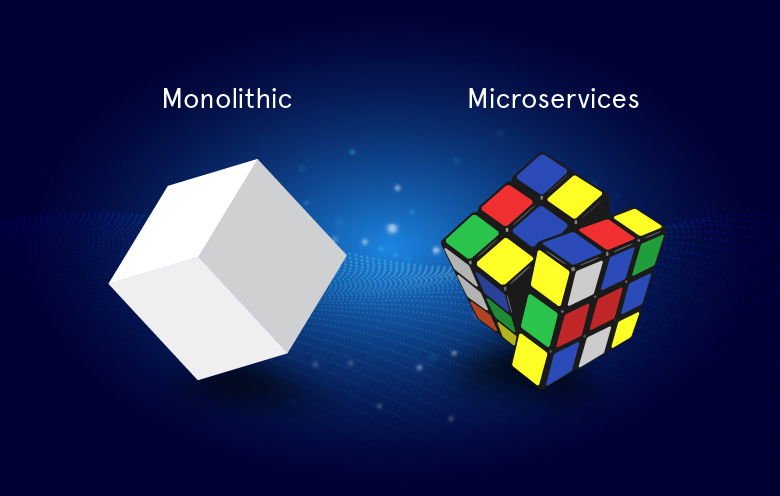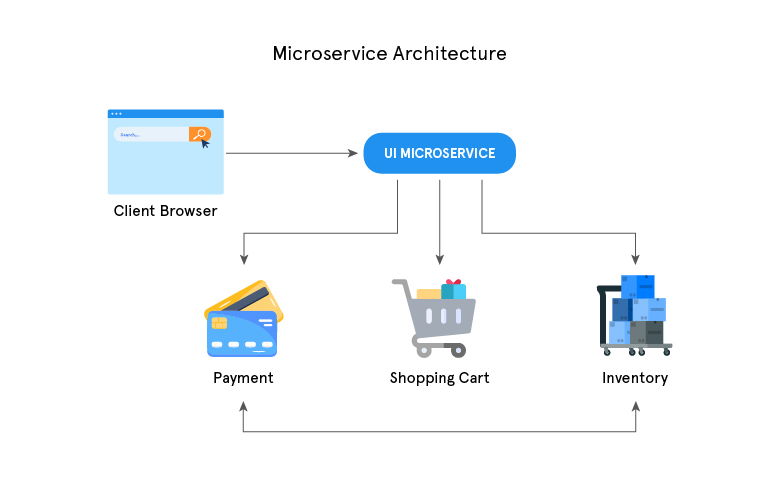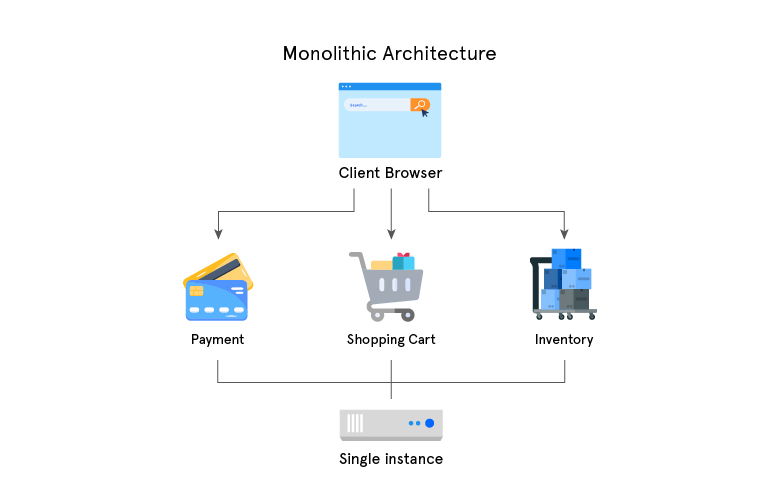Recently, microservices architecture has become more popular and is expected to become the norm. Futuristic business owners and software developers might be familiar with this monolithic vs. microservices tug of war. In the midst of this battle, market leaders such as Uber, Netflix and Amazon chose monolithic to microservices migration.
These organizations know that the core of any enterprise application is the business logic that carries out the business rules. And a microservice architecture distributes business logic among various services. There are other reasons as well to migrate from monolithic to microservices.
However, if you want to know in depth which is better for your business model, then read this blog post. We will discuss the differences between these architectures and help you to decide which is most appropriate for your business needs.
What are microservices?
The microservices architecture is a modern approach to software development that is integrated with independently deployable services. A large program is split into separate Docker containers that have self-reliant services that communicate via APIs. Most importantly, the microservices architecture relies on business-oriented APIs that combine everything into a cohesive application. This gives them a higher level of modularity than a monolithic architecture.
Unlike monolithic applications, microservices keep each block of code separate, even after deployment. You only need a single point of entry to access server-side applications, so all modules don’t have to be tethered to one server. Besides, DevOps practices are incorporated in microservices development in azure to build faster at a reduced cost.
For example, consider an e-commerce platform that has an online store, a payment gateway and a customer service system. With microservices, each of these components would be its own independent service, and they would communicate with each other through APIs.
It is estimated that the global cloud microservices platform market will generate $4.2 billion in revenue by 2028. – McKinsey
Advantages of microservices architecture for business
Make the development process flexible:
As mentioned earlier, microservices are modular and deployable, enabling increased flexibility in development. So, changes to any parts are easier as each can be developed/deployed independently. This is particularly beneficial in large and complex systems where changes to the whole system would be difficult to implement concurrently.
Allows for faster development and deployment:
Small and focused teams can work on individual microservices to simplify development and allow for faster deployment. Moreover, microservices are independently deployable. This enables them to be released and deployed separately, accelerating the development process.
Easy to scale:
Microservices are more scalable than monolithic systems, as individual microservices can be adjusted up or down as needed. This can be particularly useful in situations where different parts of the system have different scaling requirements.
Simple to test and debug:
Using microservices makes testing and debugging easier, thanks to their modularity and autonomy. Problems that arise can be addressed and identified separately, making it easier to deal with and address them. This is particularly helpful in large, complex, distributed systems, where it may be challenging to analyze the entire system.
Improve business agility and time-to-market:
Businesses can allocate optimal time, cost, and resources to functions that are critical to their current business goals and objectives by decoupling business processes. Similar decisions can be made to scale up in-demand services rather than all services at once. It eventually results in exponential savings. As a result, the microservices architecture enables businesses to maintain laser focus and prioritize services and resources critical to meeting current market demands, making them more responsive and agile.
When to use microservices?
So, when is it appropriate to use microservices? Here are some situations in which microservices might be the most appropriate choice:
Scenario – 1: Your business needs to scale rapidly. So, it can be beneficial if your business quickly adapts to changes in demand. Microservices development can help with scalability by allowing specific parts of the system to be scaled without affecting the complete application.
Scenario – 2: Microservices are a suitable choice if your system is complex and has many components that must be developed and maintained separately.
Scenario – 3: Since microservices allow you to make changes to specific components, they can be a viable option if you need to respond quickly to changing market conditions or customer needs.
Scenario – 4: As previously stated, operating microservices can be more difficult than operating a monolith. If you have the resources and expertise to manage a complex system, microservices could be the right fit for your company.
What is monolithic architecture?
It is a traditional software architecture style in which all components of an application are combined into a single, self-contained unit. The whole application is built using different layers, a user interface layer, a business layer and a persistence layer.
Monolithic systems are known to have tightly coupled processes; even minor changes can cause a slew of codebase issues. A single change can make an entire program inoperable.
For example, consider an e-commerce platform, which includes an online store, a payment gateway and a customer service system. A monolithic architecture would combine all these components into a single application that is built and deployed as a single unit. If a company wants to change the payment gateway, then it must rebuild and redeploy the entire application.
Advantages of monolithic architecture for business
Easy to develop:
Most developers and engineers prefer monolithic architecture because it is the traditional approach to building and deploying software programs — you work with a single codebase for the entire application.
Effortless to debug:
Debugging becomes more linear and intuitive because you are working with a single codebase. You can also perform end-to-end testing encompassing the entire monolithic architecture of the application.
Unchallenging to deploy:
Monolithic applications are easy to install because you only need to deploy one file or directory. Furthermore, the lack of flexibility enables you to focus solely on a single, centralized ecosystem.
Suitable for small projects:
You can use a monolithic architecture for the application when working on a small project, such as a minimum viable product or proof of concept. You will save money and deliver the MVP on time this way.
Adaptable to rigid projects:
Monolithic software architecture can solve your problems if you want to build an application that does not require scaling.
Fewer network issues:
Although issues like network latency may occur, they are less frequent than with microservices. One of the main benefits of a monolithic architecture is simplicity. Because the whole application is built and deployed as a single unit, it’s easier to develop and maintain. This can be especially useful for businesses with small teams and/or limited budgets.
When to use a monolithic architecture
Here are some situations in which benefits of monolithic architecture is notable:
Scenario 1 – If you have few resources, a monolithic architecture might be an appropriate option since it is easy to create and manage.
Scenario 2 – If your system is relatively simple and does not have many components, a monolithic architecture might work well because you may not need to implement a microservices architecture.
Scenario 3 – If your business doesn’t need to scale rapidly or make frequent changes to the system, a monolithic architecture might be a suitable choice because it’s simpler to develop and maintain.
Why migrate from monoliths to microservices?
Microservices offer several advantages over monolithic architectures. In this distributed architecture, it is easier to maintain and deploy features and further manage them independently. While a monolithic architecture can be more difficult to maintain because it’s challenging to identify and fix issues.
For example, if there is an issue with a particular component of a monolithic application, it may be challenging to determine the root cause of the problem because the total application is self-contained.
Moreover, a monolithic application poses obstacles to managing the code base, whether it’s continuous deployment or even just adding new features when needed. This is because it can only operate in one dimension and lacks flexibility making it difficult for businesses to adapt to changes in the market or customer needs.
For example, Mr. A is working on a multifaceted application with his team that is spread across geographical boundaries. In such a situation, a microservices architecture is more cost-effective and manages to scale the application seamlessly. Also, as far as team distribution is concerned, a monolith system poses challenges as Mr. A’s teams are not located in specific functional areas.
Some major reasons for migration to microservices from monolithic architecture:
- High scalability and maintainability
- Continuous delivery and deployment
- Faster development and software testability
- Improved fault isolation
- Flexible technology stack (languages, frameworks and databases)
- More maintainable code
- Increased flexibility
- Smaller development teams
The final say
In conclusion, microservice-oriented applications (MOA) are undeniably popular among businesses because they address issues that monolithic application designs do not. However, the choice between microservices and monolithic architecture depends on your business models and goals.
It’s critical to carefully consider your options and do your own research before determining. Regardless of which software architecture style you choose, it’s imperative to regularly review and assess your system to make sure it’s meeting the needs of your business. Contact us if you want to go with microservices development to create complex systems that are difficult to develop, implement, scale, or manage.






